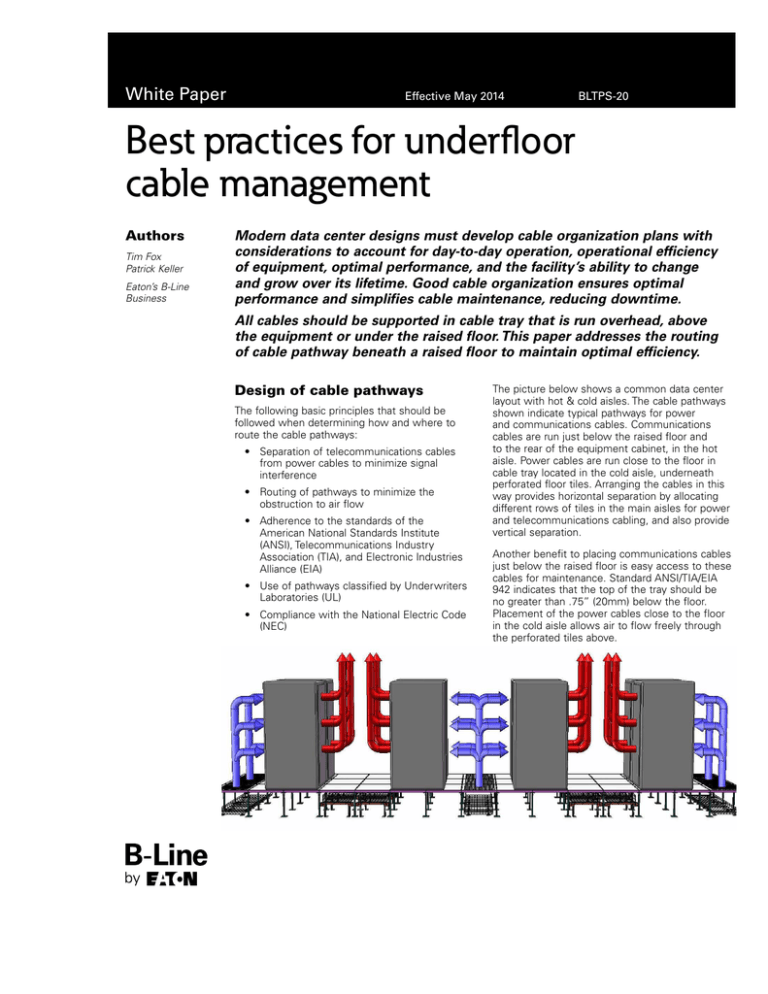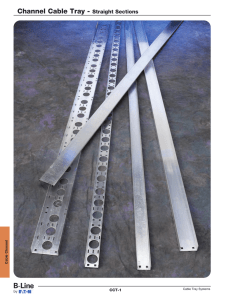
White Paper
Effective May 2014
BLTPS-20
Best practices for underfloor
cable management
Authors
Tim Fox
Patrick Keller
Eaton’s B-Line
Business
Modern data center designs must develop cable organization plans with
considerations to account for day-to-day operation, operational efficiency
of equipment, optimal performance, and the facility’s ability to change
and grow over its lifetime. Good cable organization ensures optimal
performance and simplifies cable maintenance, reducing downtime.
All cables should be supported in cable tray that is run overhead, above
the equipment or under the raised floor. This paper addresses the routing
of cable pathway beneath a raised floor to maintain optimal efficiency.
Design of cable pathways
The following basic principles that should be
followed when determining how and where to
route the cable pathways:
• Separation of telecommunications cables
from power cables to minimize signal
interference
• Routing of pathways to minimize the obstruction to air flow
•
Adherence to the standards of the
American National Standards Institute
(ANSI), Telecommunications Industry
Association (TIA), and Electronic Industries
Alliance (EIA)
• Use of pathways classified by Underwriters Laboratories (UL)
• Compliance with the National Electric Code (NEC)
The picture below shows a common data center
layout with hot & cold aisles. The cable pathways
shown indicate typical pathways for power
and communications cables. Communications
cables are run just below the raised floor and
to the rear of the equipment cabinet, in the hot
aisle. Power cables are run close to the floor in
cable tray located in the cold aisle, underneath
perforated floor tiles. Arranging the cables in this
way provides horizontal separation by allocating
different rows of tiles in the main aisles for power
and telecommunications cabling, and also provide
vertical separation.
Another benefit to placing communications cables
just below the raised floor is easy access to these
cables for maintenance. Standard ANSI/TIA/EIA
942 indicates that the top of the tray should be
no greater than .75” (20mm) below the floor.
Placement of the power cables close to the floor
in the cold aisle allows air to flow freely through
the perforated tiles above.
White Paper
Best practices for underfloor
cable management
Cable tray installation
Effective May 2014
Choice of cable trays
The most common type of cable support found in data centers
is wire basket cable tray. Wire basket is sturdy enough to support
large cable quantities, and its open structure provides adequate
cable ventilation and does not block airflow. Per the ANSI/TIA/EIA942 standard, cable tray should have a maximum depth of 150mm
(6”). Deeper cable trays can adversely affect manageability and
administration of cables. If more than 6” (150mm) of cable
depth is required, trays should be installed in multiple layers to
provide additional capacity. Since many data centers do not start
at full capacity, cable tray systems are frequently designed to
accommodate growth. Often the initial installation is a single layer,
and further layers of cable tray are installed as the data center
infrastructure grows. If the initial cables will not be accessed
after installation, a complete cable tray structure may be installed
over the initial structure. If regular access to the initial cables
is required, a cantilever system should be installed. Designers
should keep in mind that the NEC requires the removal of cables
not currently in use and access to the base structures may
be required. See ANSI/TIA-569-B for further cable tray design
considerations.
In an ideal situation, the cable tray system should not affix itself
to the raised floor. A support system that is independent from
the floor structure eliminates unnecessary load and strain on the
flooring grid. When possible, there are advantages to installing
the cable tray prior to the installation of the raised floor, including
reduced labor time and a shorter project construction timeline.
Installers will frequently choose the length of the tray pieces
installed. Congested floor subspace and raised floor stringers often
require the tray to be only 2’ long. However, if these obstructions
are not in place, the installation of 4’ and 10’ sections can reduce
installation time. In addition, longer lengths require fewer supports
and result in lower material costs.
Fiber and copper cabling in cable trays and other jointly used
pathways should be separated by a fixed solid barrier of a
material compatible with the cable tray to improve data center
administration and operation and to minimize damage to smaller
diameter fiber cables. Cable trays should be sized to accommodate
various media, and dividers should be used as necessary.
The tray system should be flexible enough to be adjusted on site
to avoid the many unforeseen obstructions under the raised floor
such as chilled water pipe. As a rule of thumb, changes in the
vertical height of the tray should be limited to a one inch change in
vertical per one foot of horizontal.
Cables installed in a raised floor
Grounding
Self-supporting cable management system
Metallic cable tray should be bonded to the data center grounding
infrastructure per the requirement of ANSI/TIA/EIA 942. The most
common method of grounding is to run a ground wire with the
cable tray and bond it to each section of the cable tray. The wire
itself must also be bonded to the raised floor ground. All ground
components and bonding methods should be UL approved per
ANSI/TIA/EIA-J-STD 607-A.
Post-installation procedures
Designing, selecting, installing, and grounding cable tray properly
allows the equipment in the data center to function at its best.
An important final step is to create ongoing cable management
procedures to be followed and updated throughout the lifespan of
the data center. Proper procedures will simplify changes, increase
efficiencies and reduce downtime.
For more information, visit www.bline.com
Eaton
1000 Eaton Boulevard
Cleveland, OH 44122
United States
Eaton.com
© 2014 Eaton
All Rights Reserved
Printed in USA
Publication No. BLTPS-20
May 2014
Eaton’s B-Line Business
509 West Monroe Street
Highland, IL 62249
United States
Phone: 800-851-7415
www.cooperbline.com/contactus
Eaton is a registered trademark.
All other trademarks are property
of their respective owners.





